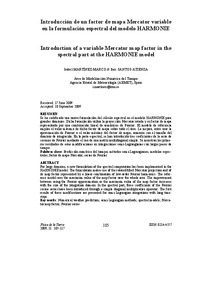Por favor, use este identificador para citar o enlazar este ítem:
http://hdl.handle.net/20.500.11765/9365
Introducción de un factor de mapa Mercator variable en la formulación espectral del modelo HARMONIE
| Título : | Introducción de un factor de mapa Mercator variable en la formulación espectral del modelo HARMONIE |
| Otros títulos : | Introduction of a variable Mercator map factor in the spectral part at the HARMONIE model |
| Autor : | Martínez Marco, Isabel


|
| Palabras clave : | Predicción numérica del tiempo; Métodos semi-Lagrangianos; Modelos espectrales; Factor de mapa Mercator; Series de Fourier; Numerical weather prediction; Semi-Lagrangian methods; Spectral models; Mercator map factor; Fourier series |
| Fecha de publicación : | 2009 |
| Editor: | Universidad Complutense de Madrid |
| Citación : | Física de la Tierra. 2009, 21, p. 105-117 |
| Versión del editor: | https://revistas.ucm.es/index.php/FITE/article/view/FITE0909110105A/11414 |
| Resumen : | [ES]Se ha codificado una nueva formulación del cálculo espectral en el modelo HARMONIE para grandes dominios. Dicha formulación utiliza la proyección Mercator rotada y su factor de mapa representado por una combinación lineal de armónicos de Fourier. El modelo de referencia emplea el valor máximo de dicho factor de mapa sobre todo el área. La mejora, entre usar la aproximación de Fourier o el valor máximo del factor de mapa, aumenta con el tamaño del dominio de integración. En la parte espectral, se han introducido tres coeficientes de la serie de cosenos de Fourier mediante el uso de una matriz multidiagonal simple. Se muestran los primeros resultados de estas modificaciones en integraciones semi-Lagrangianas con largos pasos de tiempo. [EN]For large domains, a new formulation of the spectral computation has been implemented in the HARMONIE model. The formulation makes use of the rotated/tilted Mercator projection and of its map factor represented by a linear combination of low-order Fourier harmonics. The reference model uses the maximum value of the map factor over the whole area. The improvement between using the Fourier approximation or the maximum value of the map factor increases with the size of the integration domain. In the spectral part, three coefficients of the Fourier cosine series have been introduced through a simple diagonal multiplicative operator. The first results of these modifications are presented for semi-Lagrangian integrations with long timesteps. |
| URI : | http://hdl.handle.net/20.500.11765/9365 |
| ISSN : | 0214-4557 1988-2440 |
| Colecciones: | Artículos científicos 2005-2009 |
Ficheros en este ítem:
| Fichero | Descripción | Tamaño | Formato | ||
|---|---|---|---|---|---|
| Revista_Mercator_FT_2... | 902,09 kB | Adobe PDF |  Visualizar/Abrir |
Los ítems de Arcimis están protegidos por una Licencia Creative Commons, salvo que se indique lo contrario.





